10 weird and wonderful paddling inventions

At Wash Rider we’re constantly thinking about paddler problems that we’ve either experienced ourselves or had sent in from paddlers. Most of the solutions are what you see in our range, with products seeking to improve paddling equipment for paddlers of racing canoes, kayaks or surfskis.
While designing new gear in the paddling industry we have come across some seriously weird and simply wonderful inventions to solve problems faced by paddlers. Some of them have gone on to shape the way we paddle while others have been superseded by new technology, a change in rules or passion for paddle sports.
To celebrate the most ingenious, crazy and creative solutions made by paddlers we’ve put this list together for your enjoyment and interest. Let us know the numbers of your favourite ones in the comments below.
1. Winged paddles
Introduced to the world by the Swedish flatwater sprint team in the 1980’s it didn’t take long for people to switch across from flat blades. These paddles became the standard if you wanted to be competitive.
The internet is full of theories on why and how these paddles work. Our take from hearsay and a scan of a few scientific abstracts, is largely due to the pressure difference created by the vortices and the higher stroke rate allowed by the J-stroke style.

Photo credit: Ross H Sanders & Selina J Kendal, The Australian Journal of Science and Medicine in Sport, March 1992 via Surfski.info
Regardless of why they work, we all know how well they work. As an old coach at our old club said when the wing paddle came in the average speed of the sprinters uniformly lifted and those at the back of the 1980’s marathon pack could stay on for longer.
These paddles have evolved in shape, surface area, length and construction becoming lighter, stronger and more easily transported with innovations like the split shaft adjustable joiner.

Fergs and Macka Kiwi K2 paddle by Canoe Sports
2. Winged boats
The winged K1’s were designed to let paddlers go faster with narrower hulls while still being legal for the international sprint racing standard width (beam). These narrow hull shapes provided paddlers with more speed than the previous diamond shaped K1’s and still meet the requirements for competition.
Ultimately though once these winged kayak hull shapes had made a mockery of the restrictions and athletes saw the potential to go faster the canoe federations dropped with width restrictions. Following this manufactures quickly released several new designs in the early 2000’s. This evolution of narrow hull shapes is only 20 years young so it will be interesting to see what innovations in shapes the makers come up with the coming years.
We would be really keen to hear from you in the comments if you know which country or manufacturer was the first to experiment with skinnier kayaks.

Winged K1 kayak on the trailer at the Australian Marathon Championship 2011 at Geelong Canoe Club. Manufactured by Max Kayaks.
3. Anti-Gravity-Paddle-Levitation-Device
New Zealand is known for creating some of the worlds best sprint paddlers but one of their greatest multisport athletes, Steve Gurney, created a way to float his paddle in front of him during the long paddles. This so named Anti-Gravity-Paddle-Levitation-Device was created to take the weight off his arms during the long 4 hour river kayak section of the Coast to Coast multisport race.
Think about it like you are holding a 600gram (paddle) weight in front of you for 4 hours. Your arms are going to get tired. So instead Steve’s invention saves his effort for the final cycle. This fishing rod like apparatus held paddle and still allow for a good stroke, just don’t let go 😉
Check out more of Steve’s inventions on his website here.

Photo: With permission from Steve Gurney
4. Surfski traction pads
These are simply wonderful under foot. Not only is this textured matting effective at stopping your feet from slipping off or sliding up the footplate in your surfski or K1 they are super comfortable for your feet. Comfort is one of those features of kayak and ski design which is measured with speed and lightness of craft. So, for something which weights tens of grams and keeps your feet applying power to the footplate it’s well worth using. Pick yours to fit here.
5. Wood to Composite constructions
The transition from wooden layups to composite materials was a welcome change. Significantly improving the properties of weight, durability, stiffness, while reducing the maintenance of our canoes, kayaks and surfskis these materials are now common practice.
With the new materials such as fibreglass, carbon and Kevlar clothes came new construction methods which have allowed more variety to choose from with weights, stiffness and cost. The variety of resins used across the industry now also give way to specialist applications such as the commonly used Vinylester or Derakine resins layups of fibreglass in river racing where light weight, flexible hulls that are cheap to wreck and repair on the rocks are very popular.
These lighter stronger materials were definitely one of the more wonderful inventions that have come into existence. Though a paddle in a nice Struer Kayak is always a treat.

6. Rotating seats
As if K1 kayaks weren’t tippy enough; one of two things happen when you sit on these rotating seats. You either feel much more powerful leg drive through your kayak stroke or you take a swim.
Developed and patented by Max Abott, of MAX Kayaks in Australia, these K1 seats immediately won gold in the K1 500m World Championships in 2002 and 2003. The patent was then bought in 2003/4 by Nelo Kayaks and progressed to produce several more Olympic gold medals and World Championships.
Having been a fan of these in the past we’re keen to hear your thoughts on these unstable seats. Test one and let us know what you think of the increased leg drive, and rotation through your hips and torso.

Photo ICF Media: Ken Wallace holding his K1 with rotating swivel seat installed
7. Surfski venturi
The venturi bailers have allowed surfskis to change shape and perform better on downwind ocean runs. Venturis act as a drain when moving quickly with the negative pressure from their shape creating suction to remove water from the open cockpit area of the ski.
Traditionally the cockpit would be designed with less open volume similar to the current surf lifesaving specification skis where there are smaller individual leg areas and a shallower seat to stop the cockpit from being swamped by water slowing the paddler.
The venturi bailers have allowed ocean surfskis to be built with a deeper, lower seat so you can be more balanced, have a leg drive similar to a K1 kayak and not be weighed down or swamped by water when out riding the swell on the ocean. The more recent designs of venturis can be opened and closed while paddling which streamlines the hull more and enables them to be faster off the start. 
8. The Flyak
Einar Rasmussen’s, once had a dream to create the fastest human powered boat on water. This desire lead him to create this insane hydrofoil Flyak. Enabling the amateur paddler to hit 27km/hr+ with this design.
Seeing as width restrictions for kayaks were only listed at the turn of the millennium, it might be some time before we see them in regulated competition. More recently this hydrofoil design has also shown up on a Spanish paddle blog with some substantial work done to refine the design with the team at Foil Kayak blog documenting this journey.
9. GPS watch mounts
GPS watches are now nearly as essential as a paddle and a boat. The advent of GPS watches has meant that you need a place to securely mount it on your deck where you can see it and use it in real time to inform your training and racing.
Surfskis have foot straps to mount them, canoes have the thwarts to put them around and kayaks… have watch mounts. With many designs out there we can’t go past our own Wash Rider styles of watch mounts. With the original in cockpit Spare Wrist (pictured right) and the on the deck Any Mount (pictured left) both a cheap insurance for your GPS watch.
10. Medical bags for drink bags
You never seem to forget your first time, the weird look the pharmacist gave you when you bought a set of these urinary drainage bags for drinking. For many years these medical bags gave paddlers hands free drinking while paddling. With generations of marathon paddlers teaching the next how to tape up the bags to be slung at a perfect height around your neck the night before a race.
They served their purpose before being superseded by hydration bladders, fridge bottles and purpose made drink bags.
Unfortunately, it was common practice while racing to discard the empty used bags into the water at both local and international events. In 2016, the British Canoeing Marathon Racing Committee lead the paddling world with the penalisation of paddlers caught polluting waterways with these plastic bags. Following this lead, the International Canoe Federation (ICF) introduced similar sensible rules to marathon kayak racing which penalised paddlers for discarding drink bags into the water and keeping our waterways cleaner.

Photo: Carolyn Cooper Photography. Hank McGregor (RSA), Shaun Rubenstein (RSA) & Ivan Alonso Lage (ESP) all receiving fresh medical drink bags in during the portage at a very hot and humid race in the 2009 canoe marathon world championships in Singapore.
- Kieran Babich


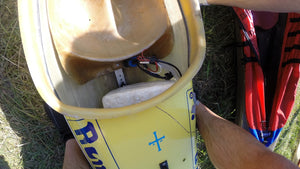
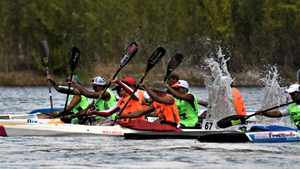
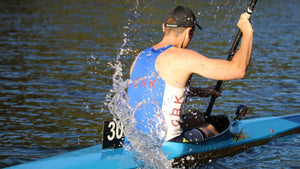
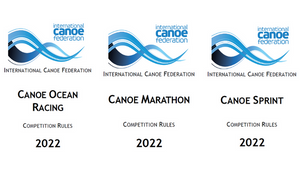
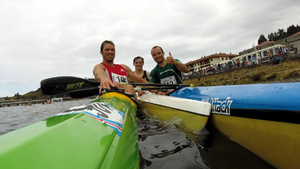
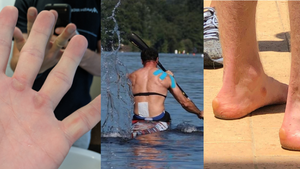
Comments 8
Dave Walker
Hi, Late comment on winged paddles. The diagram (a) and explanation of the use of traditional asymmetric is incorrect. Diagram a) shows the ‘flat’ paddle is being pulled straight back with the vortices on either side matching. But, that is not how the old racing paddle was used! The top paddles in the early ‘80s were Liminats and Struers. Prior to wings arriving, Struer actually published a description of the correct way to paddle with their blades, exactly the same way as the recommended way for wings when they arrived! The diagram a) is essentially saying the blade is used like a blade of a paddle steamer, but you don’t do that (well except the first few strokes from a standing start, particularly if you are a polo player). The blade should enter the water as far forward as possible and near the side of the boat, get the blade solidly engaged and start pulling back, unwinding at the waist, and as the blade is becoming fully loaded, you move it away from the side of the boat with the leading edge of the blade slightly forward. In aircraft terms, it has and increased angle of attack that creates lift. The blade of the paddle is being used like the blade of a propellor, not the blade of a paddle wheel! This technique means the blade has less “slippage” and so the “pull” of the stroke is more efficient as the blade can be loaded more than in a straight pull. This technique is nothing new. If you want to check back and look in the ASA handbook (the UK Amateur Swimming Association) from the early 1900s, this is the technique described for the way you use your hands when swimming breast stroke.
The wing paddle is moved in the same way, the leading edge having an angle of attack, but it also has an aerofoil like shape which presumably also creates a high pressure/low pressure differential which presumably reduces slippage some more.
Personally, I have found my wings also help me paddle with a much more accurate, consistent stroke, not a bad thing.
Hope this give some food for thought.
Kieran
Hey Herman, these are excellent references! Thank you! We’ll have to update the blog to credit Stefan Lindeberg and Leif Hakansson for inventing the wing paddle. The start bucket for sprint invention by the French is a really good one to note too! Thanks
Herman Boerrigter
Here is the US Patent of the wing paddle: https://patents.google.com/patent/US4737126A/en
Also very interesting is the starting mechanism, a French invention: https://worldwide.espacenet.com/patent/search/family/009403938/publication/FR2671017A1?q=fr2671017
Attilio
Not sure what a leap the wing paddles are for most non racing paddlers. It’s hard to get rotation/leg drive without tipping the boat and you lose a lot of power because one needs to keep a shorter stroke you have to pull the paddle out of the water a lot sooner or that also tips the boat. They only work in perfectly flat open water in ideal conditions but go on a lake, get near some rocks, get stuck in seaweed or start with an asymmetric stroke (sweep one side, high angle the other) to make a turn and things get rough. Never mind having to brace with those things.
I see the wing paddle like a muscle or dragster car: lots of math calculations backing up just one thing, unbeatable in perfect/ideal conditions going in a straight line, dodgy in everything else. The real world is made up of a lot more than the race pace equations that the perfectionists buying these things think of. For the rest of us that aren’t in a perfectly controlled environment with unwaveringly ideal stroke conditions flat paddles are more adaptable, easier and indeed faster. By a lot like 0.5mph more if conditions are rough or it’s summer and the lake is full of lilly pads/weeds. That’s what my Strava says.
Kieran (Wash Rider)
Hey Pedro, those are great resources, thanks for sharing!
Pedro Monteiro
2. Winged boats
Nelo in Portugal introduced that innovation 1998 with the Nelo Moskito (souce: https://www.nelo.eu/history/ and https://ipaddle.co.nz/pages/nelo-a-proud-history-of-olympic-innovation)
Kieran
Definitely a worthy addition Chris!
Chris Alger
What about foot-operated bailing pumps? The Hubby and Rapid Flow designs are great in that they allow you to empty your kayak with almost no effect on your paddling efficiency.